check engine Lancia Thema 2013 Owner handbook (in English)
[x] Cancel search | Manufacturer: LANCIA, Model Year: 2013, Model line: Thema, Model: Lancia Thema 2013Pages: 336, PDF Size: 3.87 MB
Page 290 of 336

Points To Remember
NOTE: When the vehicle is
stopped after a few kilometers of
operation, you may observe vapor
coming from the front of the engine
compartment. This is normally a
result of moisture from rain, or
high humidity accumulating on
the radiator and being vaporized
when the thermostat opens, allow-
ing hot engine coolant (antifreeze)
to enter the radiator.
If an examination of your engine com-
partment shows no evidence of radia-
tor or hose leaks, the vehicle may be
safely driven. The vapor will soon dis-
sipate.
Do not overfill the coolant recoverybottle.
Check engine coolant (antifreeze)
freeze point in the radiator and in
the coolant recovery bottle. If engine
coolant (antifreeze) needs to be
added, contents of coolant recovery
bottle must also be protected against
freezing.
If frequent engine coolant (anti- freeze) additions are required, or if
the level in the coolant recovery
bottle does not drop when the en-
gine cools, the cooling system
should be pressure tested for leaks.
Maintain engine coolant (antifreeze)
concentration at 50% engine coolant
(antifreeze) (minimum) and dis-
tilled water for proper corrosion pro-
tection of your engine, which con-
tains aluminum components. Make sure that the radiator and coolant recovery bottle overflow
hoses are not kinked or obstructed.
Keep the front of the radiator clean. If your vehicle is equipped with air
conditioning, keep the front of the
condenser clean.
Do not change the thermostat for Summer or Winter operation. If re-
placement is ever necessary, install
ONLY the correct type thermostat.
Other designs may result in unsat-
isfactory engine coolant (anti-
freeze) performance, poor gas mile-
age, and increased emissions. BRAKE SYSTEM
In order to assure brake system per-
formance, all brake system compo-
nents should be inspected periodi-
cally. Refer to the “Maintenance
Schedule” for the proper maintenance
intervals.
WARNING!
Riding the brakes can lead to brake
failure and possibly an accident.
Driving with your foot resting or
riding on the brake pedal can result
in abnormally high brake tempera-
tures, excessive lining wear, and
possible brake damage. You would
not have your full braking capacity
in an emergency.CAUTION!
Car maintenance should be done at
a LANCIA Dealership. For routine
and minor maintenance operations
you wish to carry out yourself, we
do recommend you have the proper
equipment, genuine LANCIA spare
(Continued)
284
Page 291 of 336

CAUTION!(Continued)
parts and the necessary fluids; do
not however carry out these opera-
tions if you have no experience.
Master Cylinder – Brake Fluid
Level Check
Check the fluid level in the master
cylinder immediately if the brake sys-
tem warning light indicates system
failure.
Check the fluid level in the master
cylinder when performing underhood
services.
Clean the top of the master cylinder
area before removing the cap. Add
fluid to bring the level up to the
“MAX” mark on the side of the master
cylinder reservoir.
Add enough fluid to bring the level up
to the requirements described on the
brake fluid reservoir. With disc
brakes, fluid level can be expected to
fall as the brake pads wear. However,
low fluid level may be caused by a
leak and a checkup may be needed. Use only manufacturer's recom-
mended brake fluid. Refer to “Fluids,
Lubricants, and Genuine Parts” in
“Maintaining Your Vehicle” for fur-
ther information.
WARNING!
Use only manufacturer's recom-
mended brake fluid. Refer to
“Fluids, Lubricants, and Genuine
Parts” in “Maintaining Your Ve-
hicle” for further information.
Using the wrong type of brake
fluid can severely damage your
brake system and/or impair its
performance. The proper type of
brake fluid for your vehicle is also
identified on the original factory
installed hydraulic master cylin-
der reservoir.
To avoid contamination from for-
eign matter or moisture, use only
new brake fluid or fluid that has
been in a tightly closed container.
Keep the master cylinder reser-
voir cap secured at all times.
Brake fluid in a open container
(Continued)
WARNING!(Continued)
absorbs moisture from the air re-
sulting in a lower boiling point.
This may cause it to boil unex-
pectedly during hard or pro-
longed braking, resulting in sud-
den brake failure. This could
result in a accident.
Overfilling the brake fluid reser- voir can result in spilling brake
fluid on hot engine parts, causing
the brake fluid to catch fire.
Brake fluid can also damage
painted and vinyl surfaces, care
should be taken to avoid its con-
tact with these surfaces.
Do not allow petroleum based
fluid to contaminate the brake
fluid. Brake seal components
could be damaged, causing par-
tial or complete brake failure.
This could result in an accident.
285
Page 292 of 336
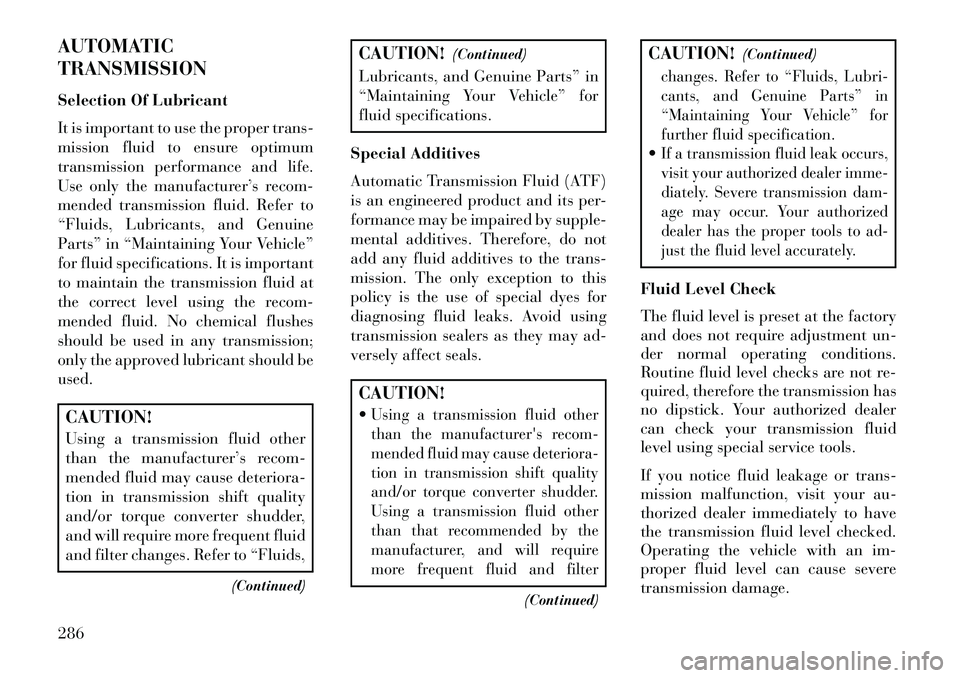
AUTOMATIC
TRANSMISSION
Selection Of Lubricant
It is important to use the proper trans-
mission fluid to ensure optimum
transmission performance and life.
Use only the manufacturer’s recom-
mended transmission fluid. Refer to
“Fluids, Lubricants, and Genuine
Parts” in “Maintaining Your Vehicle”
for fluid specifications. It is important
to maintain the transmission fluid at
the correct level using the recom-
mended fluid. No chemical flushes
should be used in any transmission;
only the approved lubricant should be
used.CAUTION!
Using a transmission fluid other
than the manufacturer’s recom-
mended fluid may cause deteriora-
tion in transmission shift quality
and/or torque converter shudder,
and will require more frequent fluid
and filter changes. Refer to “Fluids,(Continued)
CAUTION!(Continued)
Lubricants, and Genuine Parts” in
“Maintaining Your Vehicle” for
fluid specifications.
Special Additives
Automatic Transmission Fluid (ATF)
is an engineered product and its per-
formance may be impaired by supple-
mental additives. Therefore, do not
add any fluid additives to the trans-
mission. The only exception to this
policy is the use of special dyes for
diagnosing fluid leaks. Avoid using
transmission sealers as they may ad-
versely affect seals.CAUTION!
Using a transmission fluid other
than the manufacturer's recom-
mended fluid may cause deteriora-
tion in transmission shift quality
and/or torque converter shudder.
Using a transmission fluid other
than that recommended by the
manufacturer, and will require
more frequent fluid and filter
(Continued)
CAUTION! (Continued)changes. Refer to “Fluids, Lubri-
cants, and Genuine Parts” in
“Maintaining Your Vehicle” for
further fluid specification.If a transmission fluid leak occurs,
visit your authorized dealer imme-
diately. Severe transmission dam-
age may occur. Your authorized
dealer has the proper tools to ad-
just the fluid level accurately.
Fluid Level Check
The fluid level is preset at the factory
and does not require adjustment un-
der normal operating conditions.
Routine fluid level checks are not re-
quired, therefore the transmission has
no dipstick. Your authorized dealer
can check your transmission fluid
level using special service tools.
If you notice fluid leakage or trans-
mission malfunction, visit your au-
thorized dealer immediately to have
the transmission fluid level checked.
Operating the vehicle with an im-
proper fluid level can cause severe
transmission damage.
286
Page 317 of 336

Thousands Of Kilometers 24 48 72 96 120 144 168 192Months 12 24 36 48 60 72 84 96
Inspect and replace PCV valve if necessary.
Check battery charge status and possibly recharge.
Check tire condition/wear and adjust pressure, if necessary.
Check operation of lighting system (headlamps, direction
indicators, hazard warning lights, luggage compartment,
passenger compartment, glove compartment, instrument panel
warning lights, etc.).
Check operation of windscreen washer system and adjust jets
if necessary.
Check windshield/rear window wiper blade position/wear.
Check cleanliness of hood and tailgate locks and cleanliness
and lubrication of linkages.
Visually inspect condition of: exterior bodywork, underbody
protection, pipes and hoses (exhaust - fuel system - brakes),
rubber elements (boots, sleeves, bushes, etc.).
Check conditions and wear of front disc brake pads.
Check conditions and wear of rear disc brake pads.
Check and, if necessary, top up fluid levels
(brakes, windshield washer, battery, engine coolant, etc.).
Visually inspect the condition of accessory drive belt/s.
Adjust parking brake shoes as necessary.
Check exhaust gas emissions.
311
Page 318 of 336
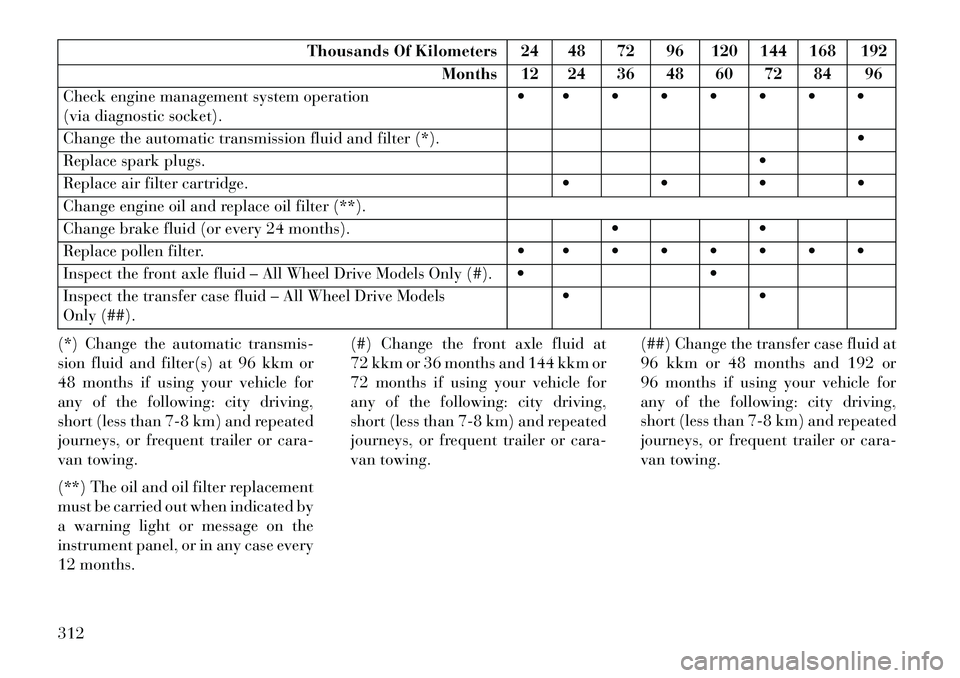
Thousands Of Kilometers 24 48 72 96 120 144 168 192Months 12 24 36 48 60 72 84 96
Check engine management system operation
(via diagnostic socket).
Change the automatic transmission fluid and filter (*).
Replace spark plugs.
Replace air filter cartridge.
Change engine oil and replace oil filter (**).
Change brake fluid (or every 24 months).
Replace pollen filter.
Inspect the front axle fluid – All Wheel Drive Models Only (#).
Inspect the transfer case fluid – All Wheel Drive Models
Only (##).
(*) Change the automatic transmis-
sion fluid and filter(s) at 96 kkm or
48 months if using your vehicle for
any of the following: city driving,
short (less than 7-8 km) and repeated
journeys, or frequent trailer or cara-
van towing.
(**) The oil and oil filter replacement
must be carried out when indicated by
a warning light or message on the
instrument panel, or in any case every
12 months. (#) Change the front axle fluid at
72 kkm or 36 months and 144 kkm or
72 months if using your vehicle for
any of the following: city driving,
short (less than 7-8 km) and repeated
journeys, or frequent trailer or cara-
van towing.
(##) Change the transfer case fluid at
96 kkm or 48 months and 192 or
96 months if using your vehicle for
any of the following: city driving,
short (less than 7-8 km) and repeated
journeys, or frequent trailer or cara-
van towing.
312
Page 319 of 336
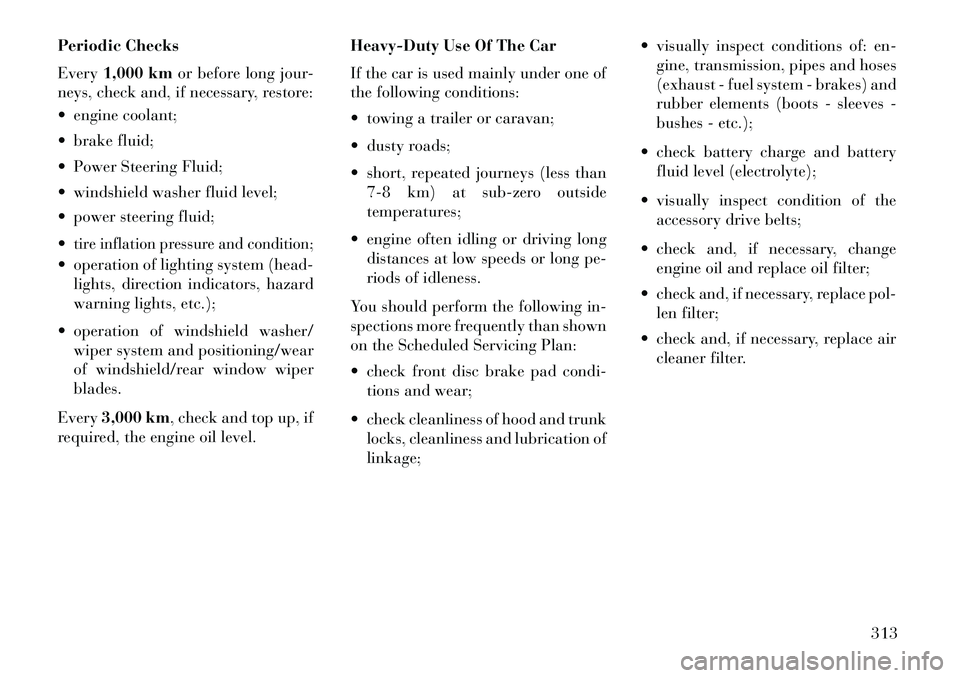
Periodic Checks
Every1,000 km or before long jour-
neys, check and, if necessary, restore:
engine coolant;
brake fluid;
Power Steering Fluid;
windshield washer fluid level;
power steering fluid;
tire inflation pressure and condition; operation of lighting system (head- lights, direction indicators, hazard
warning lights, etc.);
operation of windshield washer/ wiper system and positioning/wear
of windshield/rear window wiper
blades.
Every 3,000 km, check and top up, if
required, the engine oil level. Heavy-Duty Use Of The Car
If the car is used mainly under one of
the following conditions:
towing a trailer or caravan;
dusty roads;
short, repeated journeys (less than
7-8 km) at sub-zero outside
temperatures;
engine often idling or driving long distances at low speeds or long pe-
riods of idleness.
You should perform the following in-
spections more frequently than shown
on the Scheduled Servicing Plan:
check front disc brake pad condi- tions and wear;
check cleanliness of hood and trunk locks, cleanliness and lubrication of
linkage; visually inspect conditions of: en-
gine, transmission, pipes and hoses
(exhaust - fuel system - brakes) and
rubber elements (boots - sleeves -
bushes - etc.);
check battery charge and battery fluid level (electrolyte);
visually inspect condition of the accessory drive belts;
check and, if necessary, change engine oil and replace oil filter;
check and, if necessary, replace pol- len filter;
check and, if necessary, replace air cleaner filter.
313
Page 321 of 336

Thousands Of Kilometers 20 40 60 80 100 120 140 160Months 12 24 36 48 60 72 84 96
Check battery charge status and possibly recharge.
Check tire condition/wear and adjust pressure, if necessary.
Check operation of lighting system (headlamps, direction
indicators, hazard warning lights, luggage compartment,
passenger compartment, glove compartment, instrument panel
warning lights, etc.).
Check operation of windscreen washer system and adjust jets
if necessary.
Check windshield/rear window wiper blade position/wear.
Check cleanliness of hood and tailgate locks and cleanliness
and lubrication of linkages.
Visually inspect condition of: exterior bodywork, underbody
protection, pipes and hoses (exhaust - fuel system - brakes),
rubber elements (boots, sleeves, bushes, etc.).
Check conditions and wear of front disc brake pads.
Check conditions and wear of rear disc brake pads.
Check and, if necessary, top up fluid levels
(brakes, windshield washer, battery, engine coolant, etc.).
Visually inspect the condition of accessory drive belt/s.
Adjust parking brake shoes as necessary.
Check exhaust gas emissions.
Check engine management system operation
(via diagnostic socket).
315
Page 322 of 336
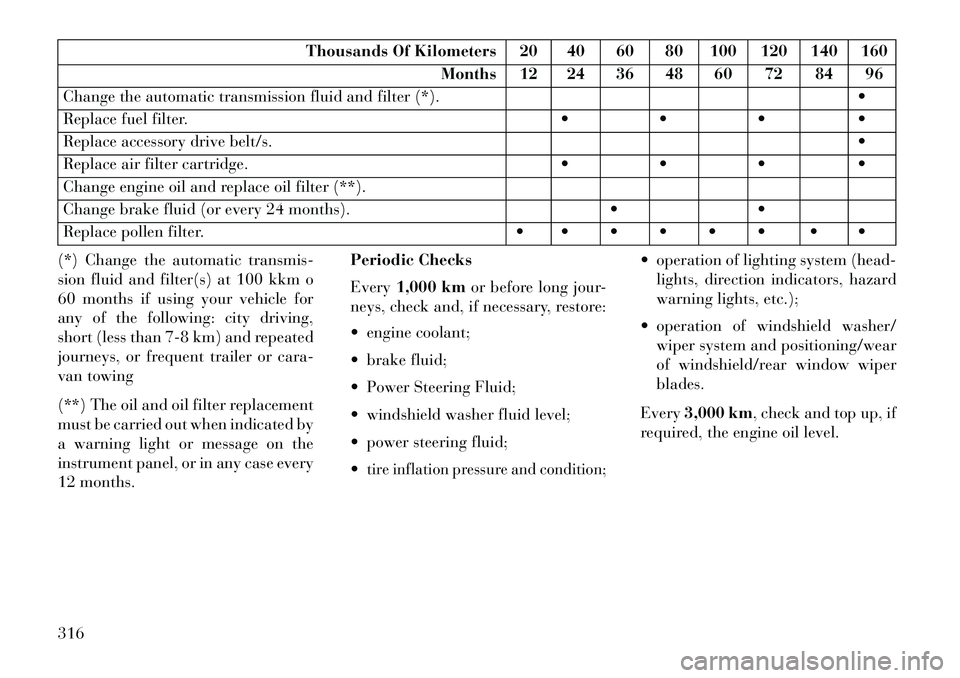
Thousands Of Kilometers 20 40 60 80 100 120 140 160Months 12 24 36 48 60 72 84 96
Change the automatic transmission fluid and filter (*).
Replace fuel filter.
Replace accessory drive belt/s.
Replace air filter cartridge.
Change engine oil and replace oil filter (**).
Change brake fluid (or every 24 months).
Replace pollen filter.
(*) Change the automatic transmis-
sion fluid and filter(s) at 100 kkm o
60 months if using your vehicle for
any of the following: city driving,
short (less than 7-8 km) and repeated
journeys, or frequent trailer or cara-
van towing
(**) The oil and oil filter replacement
must be carried out when indicated by
a warning light or message on the
instrument panel, or in any case every
12 months. Periodic Checks
Every
1,000 km or before long jour-
neys, check and, if necessary, restore:
engine coolant;
brake fluid;
Power Steering Fluid;
windshield washer fluid level;
power steering fluid;
tire inflation pressure and condition;
operation of lighting system (head- lights, direction indicators, hazard
warning lights, etc.);
operation of windshield washer/ wiper system and positioning/wear
of windshield/rear window wiper
blades.
Every 3,000 km, check and top up, if
required, the engine oil level.
316
Page 323 of 336
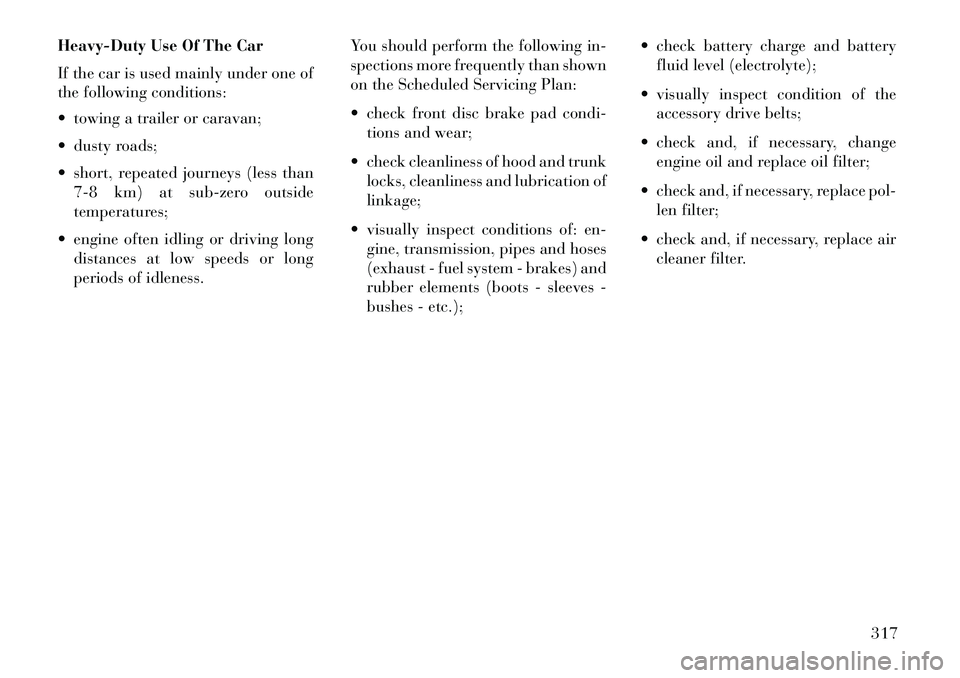
Heavy-Duty Use Of The Car
If the car is used mainly under one of
the following conditions:
towing a trailer or caravan;
dusty roads;
short, repeated journeys (less than7-8 km) at sub-zero outside
temperatures;
engine often idling or driving long distances at low speeds or long
periods of idleness. You should perform the following in-
spections more frequently than shown
on the Scheduled Servicing Plan:
check front disc brake pad condi-
tions and wear;
check cleanliness of hood and trunk locks, cleanliness and lubrication of
linkage;
visually inspect conditions of: en- gine, transmission, pipes and hoses
(exhaust - fuel system - brakes) and
rubber elements (boots - sleeves -
bushes - etc.); check battery charge and battery
fluid level (electrolyte);
visually inspect condition of the accessory drive belts;
check and, if necessary, change engine oil and replace oil filter;
check and, if necessary, replace pol- len filter;
check and, if necessary, replace air cleaner filter.
317
Page 326 of 336
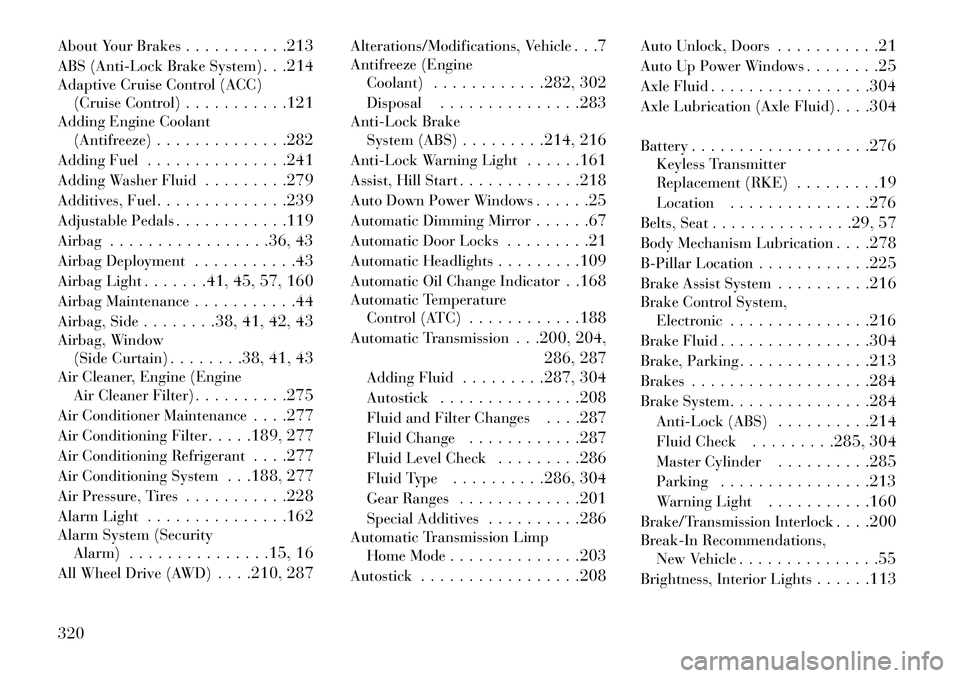
About Your Brakes. . . . . . . . . . .213
ABS (Anti-Lock Brake System) . . .214
Adaptive Cruise Control (ACC) (Cruise Control) . . . . . . . . . . .121
Adding Engine Coolant (Antifreeze) . . . . . . . . . . . . . .282
Adding Fuel . . . . . . . . . . . . . . .241
Adding Washer Fluid . . . . . . . . .279
Additives, Fuel . . . . . . . . . . . . . .239
Adjustable Pedals . . . . . . . . . . . .119
Airbag . . . . . . . . . . . . . . . . .36, 43
Airbag Deployment . . . . . . . . . . .43
Airbag Light . . . . . . .41, 45, 57, 160
Airbag Maintenance . . . . . . . . . . .44
Airbag, Side . . . . . . . .38, 41, 42, 43
Airbag, Window (Side Curtain) . . . . . . . .38, 41, 43
Air Cleaner, Engine (Engine Air Cleaner Filter) . . . . . . . . . .275
Air Conditioner Maintenance . . . .277
Air Conditioning Filter . . . . .189, 277
Air Conditioning Refrigerant . . . .277
Air Conditioning System . . .188, 277
Air Pressure, Tires . . . . . . . . . . .228
Alarm Light . . . . . . . . . . . . . . .162
Alarm System (Security Alarm) . . . . . . . . . . . . . . .15, 16
All Wheel Drive (AWD) . . . .210, 287Alterations/Modifications, Vehicle
. . .7
Antifreeze (Engine Coolant) . . . . . . . . . . . .282, 302
Disposal . . . . . . . . . . . . . . .283
Anti-Lock Brake System (ABS) . . . . . . . . .214, 216
Anti-Lock Warning Light . . . . . .161
Assist, Hill Start . . . . . . . . . . . . .218
Auto Down Power Windows . . . . . .25
Automatic Dimming Mirror . . . . . .67
Automatic Door Locks . . . . . . . . .21
Automatic Headlights . . . . . . . . .109
Automatic Oil Change Indicator . .168
Automatic Temperature Control (ATC) . . . . . . . . . . . .188
Automatic Transmission . . .200, 204,
286, 287
Adding Fluid . . . . . . . . .287, 304
Autostick . . . . . . . . . . . . . . .208
Fluid and Filter Changes . . . .287
Fluid Change . . . . . . . . . . . .287
Fluid Level Check . . . . . . . . .286
Fluid Type . . . . . . . . . .286, 304
Gear Ranges . . . . . . . . . . . . .201
Special Additives . . . . . . . . . .286
Automatic Transmission Limp Home Mode . . . . . . . . . . . . . .203
Autostick . . . . . . . . . . . . . . . . .208 Auto Unlock, Doors
. . . . . . . . . . .21
Auto Up Power Windows . . . . . . . .25
Axle Fluid . . . . . . . . . . . . . . . . .304
Axle Lubrication (Axle Fluid) . . . .304
Battery . . . . . . . . . . . . . . . . . . .276
Keyless Transmitter
Replacement (RKE) . . . . . . . . .19
Location . . . . . . . . . . . . . . .276
Belts, Seat . . . . . . . . . . . . . . .29, 57
Body Mechanism Lubrication . . . .278
B-Pillar Location . . . . . . . . . . . .225
Brake Assist System . . . . . . . . . .216
Brake Control System, Electronic . . . . . . . . . . . . . . .216
Brake Fluid . . . . . . . . . . . . . . . .304
Brake, Parking . . . . . . . . . . . . . .213
Brakes . . . . . . . . . . . . . . . . . . .284
Brake System . . . . . . . . . . . . . . .284
Anti-Lock (ABS) . . . . . . . . . .214
Fluid Check . . . . . . . . .285, 304
Master Cylinder . . . . . . . . . .285
Parking . . . . . . . . . . . . . . . .213
Warning Light . . . . . . . . . . .160
Brake/Transmission Interlock . . . .200
Break-In Recommendations, New Vehicle . . . . . . . . . . . . . . .55
Brightness, Interior Lights . . . . . .113
320